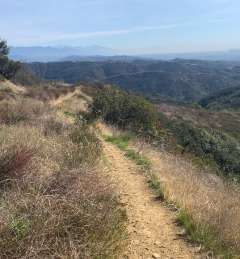COVID and the Art of Mountain Biking
Winter 2021

Mountain Biking Guidance #3:
What would you do if a dead pig dropped into the trail in front of you?
While mountain biking many years ago, I ran into an older cyclist and rode with him for a while. He tended to wax poetic about the scenery and the trail. He talked about his experiences in the mountains and his ideas about mountain biking. These came to me, in later thought, to appear as something like the Art of Mountain Biking. He had several consistent guiding ideas. Mountain Biking Guidance #1 was: “enjoy the ride”. Mountain Biking Guidance #2 articulated the secret ethos of most riders: “go as fast as possible”. This guidance has unfortunately led to several personal surgeries. Mountain Biking Guidance #3 was an answer to this question: “what would you do if a dead pig drops into the trail in front of you?” The response to this metaphorical event is that you do not immediately change your speed, posture, or center of gravity. In other words, do not panic. Keep your weight distributed evenly and slightly back, your center of gravity low, and your touch on the handlebars light. In mountain biking lingo—maintain what is called “attack position”. Do not suddenly brake, veer off the path, or radically change your posture, or you will crash because of your actions themselves—never mind the obstacle.
If there is an Art of Mountain Biking then it has meaning in a larger sense, and this year is that proof. When we are traveling down a path with clear forward vision and the unexpected happens, what are we going to do? If we have detailed plans and expectations and a pandemic hits, how do we handle this?
Faculty and staff in the UCLA Neurology Department did not panic. Clinical care continued with a seamless move into telemedicine. Research labs constricted the number of personnel on-site, but used video conferencing, and established new structures to expand data analysis and experiments. Medical student and resident education also pivoted to video contact and then to structured interactions at reduced personnel densities. These responses required a lot of work and also led to interesting new directions. The following vignettes from our Stroke Service, a clinical research lab, and our residency education office indicate how the critical missions of academic neurology reset and carried on during the pandemic. In these examples, UCLA Neurology faculty uncovered new information on how the COVID-19 virus leads to severe infection, changed the care of stroke patients, investigated how the COVID virus causes stroke, and developed a virtual Neurology Residency interview process for young doctors in training.
In life, there are inevitable and unforeseen risks. We may hit the pig, but we keep on the bike and then continue down the trail.
Next Story: Precision Medicine Discovers Underlying Risk Factors for Severe COVID Infection in Latinx Population